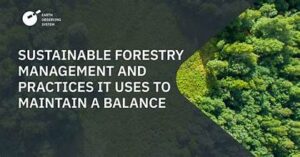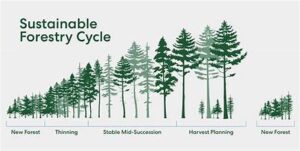
Forestry management is undergoing a transformative shift as communities worldwide increasingly take charge of their local environments. This approach not only fosters sustainable practices but also empowers local populations to play a critical role in preserving their natural heritage. As we move into 2024, the growing role of local involvement in forestry management presents a vital opportunity for enhancing ecological balance, promoting economic growth, and fostering social cohesion. This article delves into how community engagement is shaping forestry practices and why it’s becoming an essential component in effective environmental stewardship.
The Importance of Community Involvement in Forestry Management
1. Enhancing Environmental Sustainability
Forestry management has traditionally been dominated by top-down approaches, often disconnected from the local contexts and needs. However, involving communities in decision-making processes ensures that forestry practices are better aligned with the specific environmental conditions and cultural values of the area. Local knowledge and traditional practices can contribute significantly to maintaining biodiversity, managing forest health, and mitigating the effects of climate change.
Communities possess an intricate understanding of their local ecosystems, which can be invaluable in identifying and addressing environmental issues. For example, indigenous communities often have centuries of experience in managing forests sustainably, utilizing techniques that modern science is only beginning to understand. Their involvement helps integrate these traditional practices with contemporary methods, creating a more holistic approach to forest management.
2. Promoting Economic Development
Engaging local communities in forestry management can also drive economic benefits. Community-managed forests can offer various economic opportunities, such as sustainable logging, non-timber forest products, and eco-tourism. By allowing local people to participate in and benefit from forest management, communities are more likely to support and invest in conservation efforts.
Sustainable forest management practices that include local input can create jobs and stimulate local economies. For instance, community-based forest enterprises can provide employment opportunities in areas like forest monitoring, eco-tourism, and forest product processing. This economic involvement not only enhances livelihoods but also builds a stronger connection between people and their forests.
3. Strengthening Social Cohesion
Forestry management that involves local communities fosters a sense of ownership and responsibility towards forest resources. When communities are actively engaged in managing their forests, they are more likely to work together to address challenges and protect their natural environment. This collaborative approach helps build trust among community members and between the community and external stakeholders, such as government agencies and NGOs.
Moreover, involving diverse community groups, including women and youth, in forestry management ensures that different perspectives are considered. This inclusivity can lead to more equitable decision-making processes and outcomes, enhancing social cohesion and resilience.
Strategies for Effective Community Involvement
1. Building Partnerships
Successful community involvement in forestry management often begins with establishing strong partnerships between local communities, government agencies, and other stakeholders. Building these partnerships requires clear communication, mutual respect, and a shared vision for forest management.
Engaging communities from the outset and involving them in the planning and decision-making processes ensures that their needs and concerns are addressed. Collaborative workshops, public consultations, and stakeholder meetings can facilitate this engagement and help build a sense of ownership and commitment among all parties involved.
2. Providing Education and Training
Education and training are crucial for empowering communities to take an active role in forestry management. Providing local communities with the necessary knowledge and skills enables them to make informed decisions and implement effective management practices.
Training programs can cover various aspects of forestry management, such as sustainable harvesting techniques, forest health monitoring, and conservation strategies. Additionally, educational initiatives can raise awareness about the importance of forests and the benefits of sustainable management, fostering a culture of environmental stewardship.
3. Supporting Local Initiatives
Supporting and funding local initiatives is essential for empowering communities in forestry management. This support can take various forms, such as financial assistance, technical support, and capacity-building programs.
Grants and subsidies can help communities develop and implement their forestry management plans, while technical assistance can provide expertise and resources for managing forests effectively. Capacity-building programs can enhance local governance structures, enabling communities to manage their forest resources more efficiently.
Case Studies of Successful Community Involvement
1. The REDD+ Program in Tanzania
The REDD+ (Reducing Emissions from Deforestation and Forest Degradation) program in Tanzania is a notable example of successful community involvement in forestry management. Through this program, local communities are engaged in forest conservation efforts and benefit from carbon credits generated by preserving their forests.
The program has led to improved forest management practices, increased forest cover, and enhanced livelihoods for participating communities. By providing financial incentives and involving communities in monitoring and reporting, the REDD+ program has demonstrated the potential of community-based approaches to achieving sustainable forest management.
2. The Community Forests Program in Nepal
Nepal’s Community Forests Program is another successful example of local involvement in forestry management. Under this program, local communities are granted management rights over designated forest areas, allowing them to make decisions about forest use and conservation.
The program has resulted in significant improvements in forest conditions, increased biodiversity, and enhanced local livelihoods. By empowering communities to take control of their forest resources, the program has demonstrated the effectiveness of community-based forest management in achieving environmental and social goals.
Challenges and Future Directions
Despite the benefits, community involvement in forestry management also faces challenges. These challenges include conflicts over land rights, inadequate funding, and limited technical expertise. Addressing these challenges requires continued efforts to strengthen partnerships, provide support, and build local capacities.
Looking ahead, the role of local involvement in forestry management is likely to continue growing as communities and stakeholders recognize its importance. By leveraging local knowledge, promoting economic opportunities, and fostering social cohesion, community-based approaches can contribute to more sustainable and resilient forest management practices.
In conclusion, empowering communities in forestry management is not just a trend but a crucial component of effective environmental stewardship. As we advance into 2024, the growing role of local involvement offers a promising path towards achieving sustainable forest management and fostering stronger, more resilient communities. By embracing this approach, we can ensure that our forests are managed in a way that benefits both people and the environment for generations to come.


